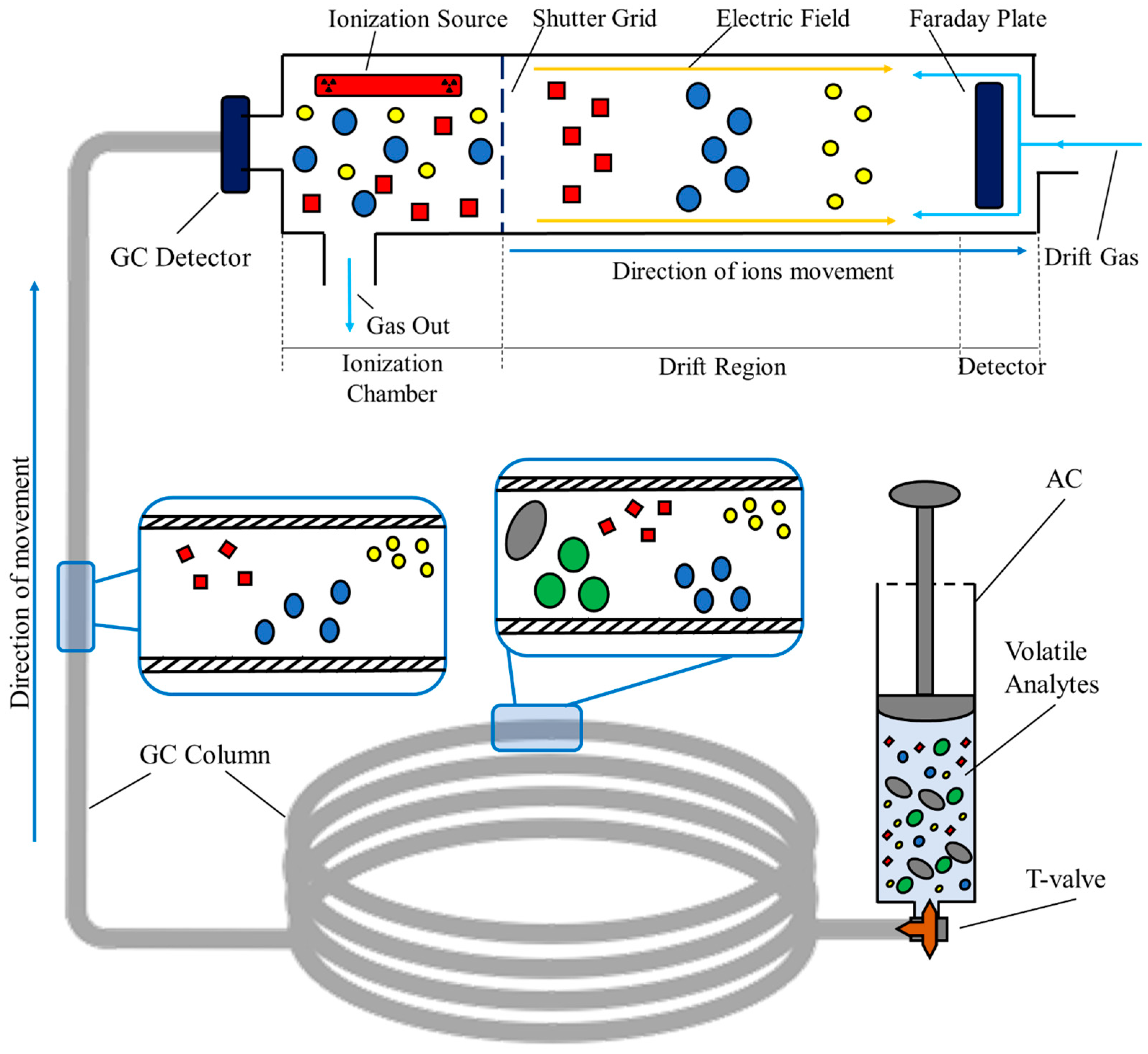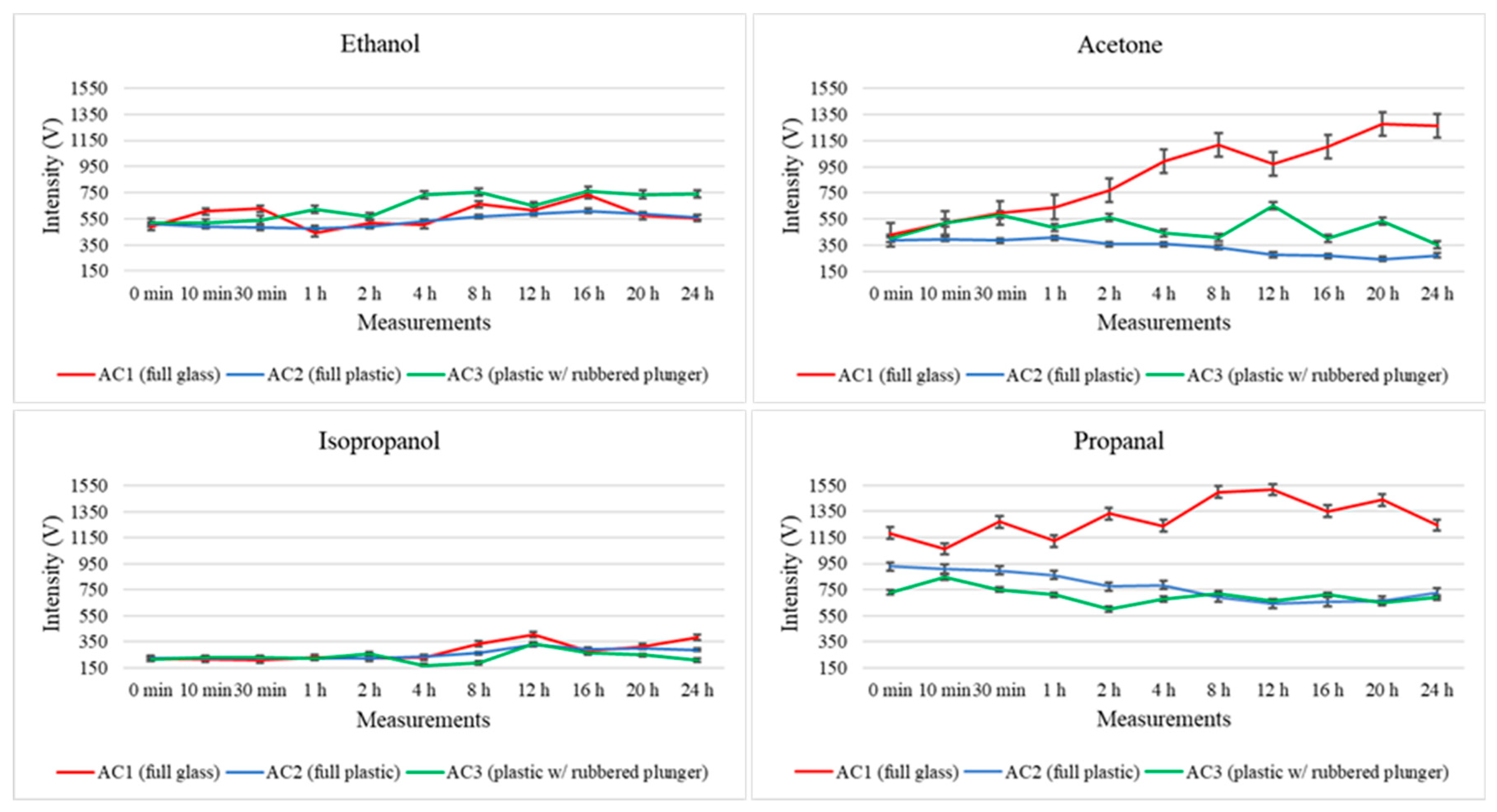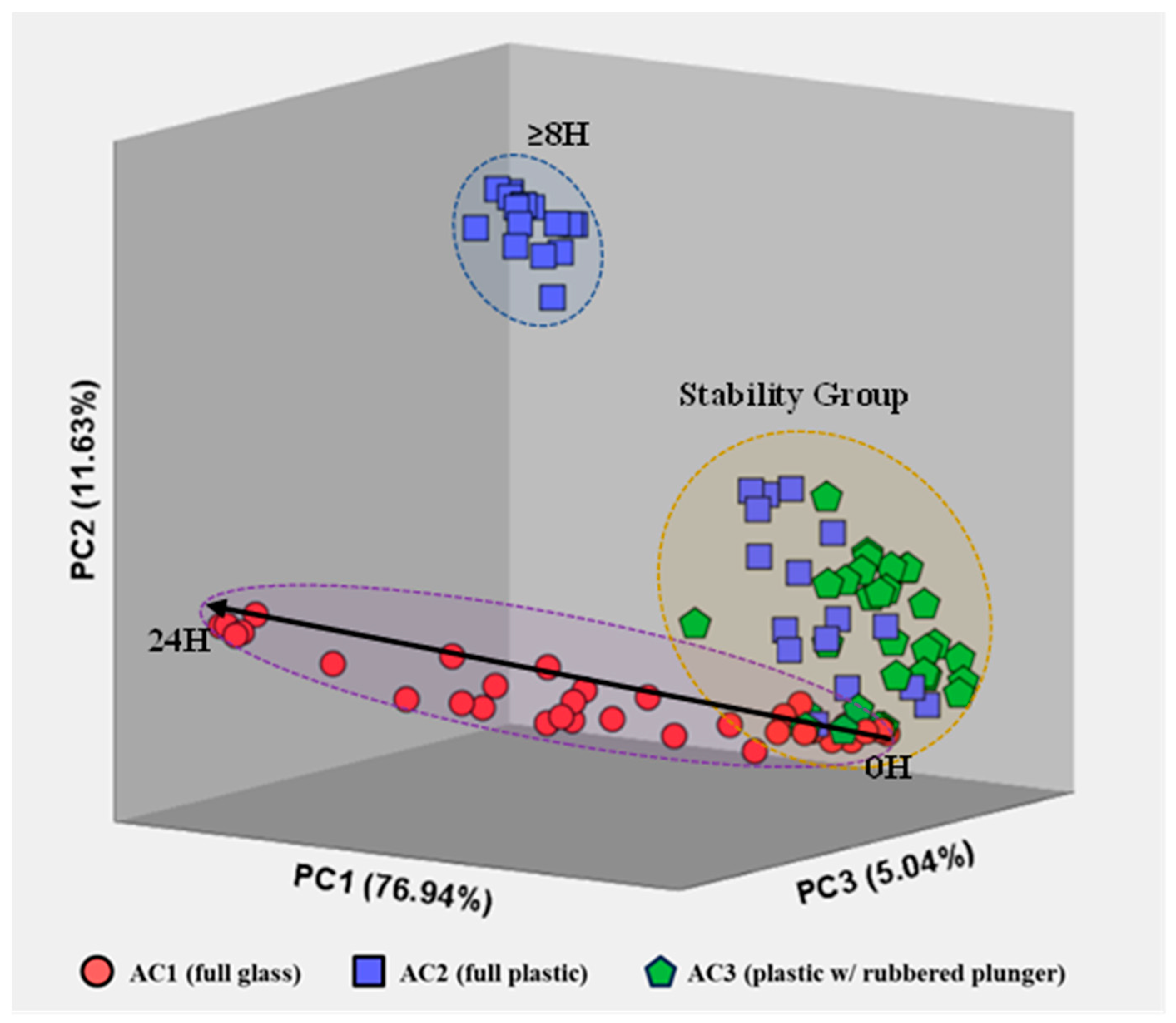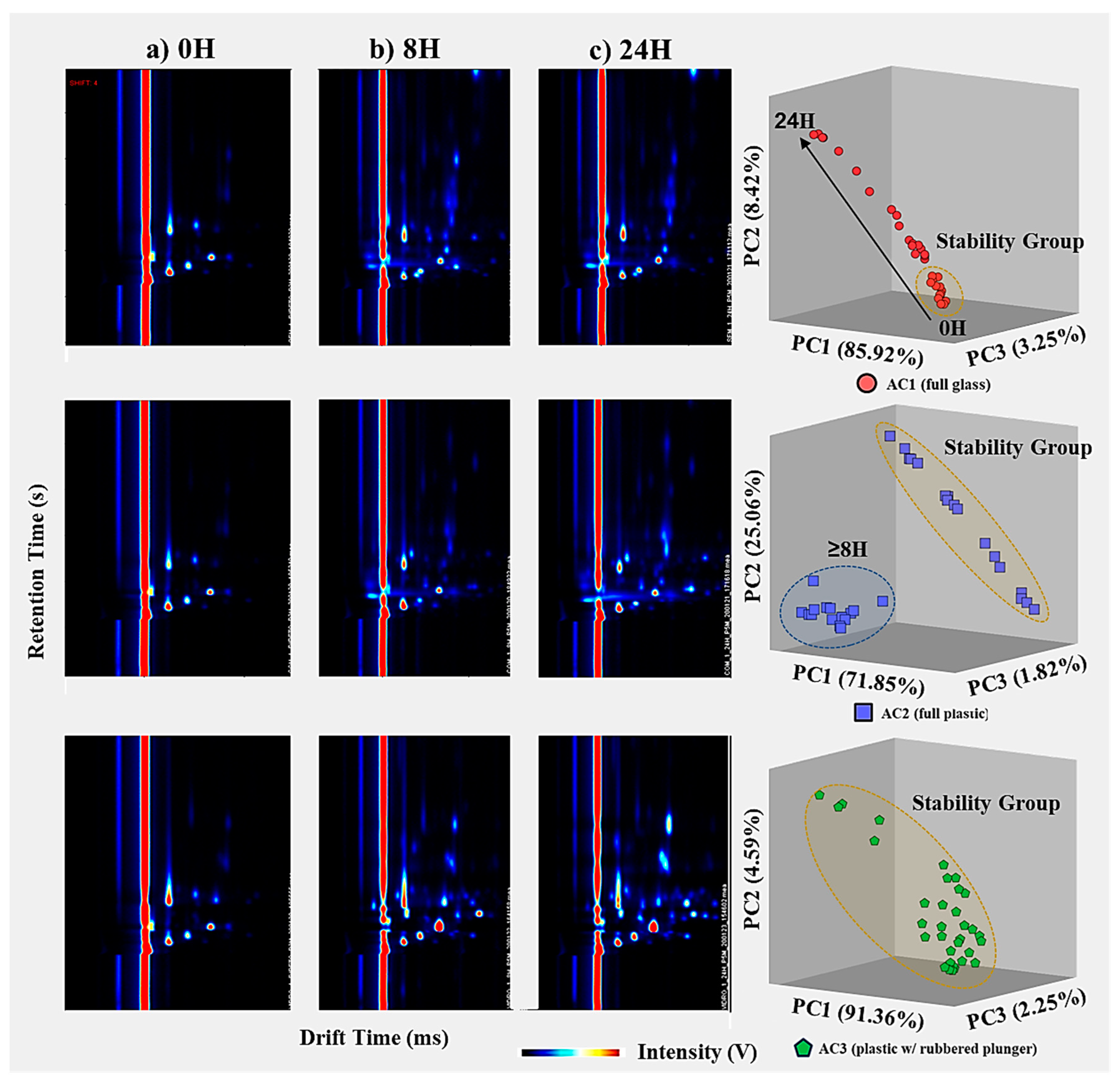Suitability of Short- and Long-Term Storage of Volatile Organic Compounds Samples in Syringe-Based Containers: A Comparison Study
Abstract
1. Introduction
2. Materials and Methods
2.1. Air Storage Containers
2.2. Sample Collection and Storage
2.3. Sample Analysis
2.3.1. IMS-Based Technologies
2.3.2. Analysis Settings and Parameters
2.4. Data Analysis and Data Validation
3. Results and Discussion
3.1. Sample Repeatability
3.2. Sample Degradation and Compositional Variation
3.2.1. Air Storage in Glass Syringe with Glass Plunger (AC1)
3.2.2. Air Storage in Plastic Syringe with Plastic Plunger (AC2)
3.2.3. Air Storage in Plastic Syringe with Rubber Plunger (AC3)
4. Conclusions
Author Contributions
Funding
Institutional Review Board Statement
Informed Consent Statement
Data Availability Statement
Acknowledgments
Conflicts of Interest
References
- Orecchio, S.; Fiore, M.; Barreca, S.; Vara, G. Volatile profiles of emissions from different activities analyzed using canister samplers and gas chromatography-mass spectrometry (GC/MS) analysis: A case study. Int. J. Environ. Res. Public Health 2017, 14, 195. [Google Scholar] [CrossRef] [PubMed]
- Barreca, S.; La Bella, S.; Maggio, A.; Licata, M.; Buscemi, S.; Leto, C.; Pace, A.; Tuttolomondo, T. Flavoring extra-virgin olive oil with aromatic and medicinal plants essential oils stabilizes oleic acid composition during photo-oxidative stress. Agriculture 2021, 11, 266. [Google Scholar] [CrossRef]
- Phillips, M.; Herrera, J.; Krishnan, S.; Zain, M.; Greenberg, J.; Cataneo, R.N. Variation in volatile organic compounds in the breath of normal humans. J. Chromatogr. B Biomed. Sci. Appl. 1999, 729, 75–88. [Google Scholar] [CrossRef]
- Dragonieri, S.; Schee, M.P.; Massaro, T.; Schiavulli, N.; Brinkman, P.; Pinca, A.; Carratú, P.; Spanevello, A.; Resta, O.; Musti, M.; et al. An electronic nose distinguishes exhaled breath of patients with Malignant Pleural Mesothelioma from controls. Lung Cancer 2012, 75, 326–331. [Google Scholar] [CrossRef]
- Buszewski, B.; Kesy, M.; Ligor, T.; Amann, A. Human exhaled air analytics: Biomarkers of diseases. Biomed. Chromatogr. 2007, 21, 553–566. [Google Scholar] [CrossRef] [PubMed]
- Amann, A.; Miekisch, W.; Schubert, J.; Buszewski, B.; Ligor, T.; Jezierski, T.; Pleil, J.; Risby, T. Analysis of exhaled breath for disease detection. Annu. Rev. Anal. Chem. 2014, 7, 455–482. [Google Scholar] [CrossRef]
- Kim, K.; Szulejko, J.E.; Jo, H.; Lee, M.; Kim, Y.; Kwon, E.; Ma, C.; Kumar, P. Measurements of major VOCs released into the closed cabin environment of different automobiles under various engine and ventilation scenarios. Environ. Pollut. 2016, 215, 340–346. [Google Scholar] [CrossRef]
- Kim, K.; Kabir, E.; Jahan, S.A. Exposure to pesticides and the associated human health effects. Sci. Total Environ. 2017, 575, 525–535. [Google Scholar] [CrossRef]
- Kim, K.; Jahan, S.A.; Kabir, E.; Brown, R.J. A review of airborne polycyclic aromatic hydrocarbons (PAHs) and their human health effects. Environ. Int. 2013, 60, 71–80. [Google Scholar] [CrossRef]
- Weschler, C.J.; Nazaroff, W.W. Semivolatile organic compounds in indoor environments. Atmos. Environ. 2008, 42, 9018–9040. [Google Scholar] [CrossRef]
- Moura, P.C.; Vassilenko, V. Long-term in situ air quality assessment in closed environments: A gas chromatography–ion mobility spectrometry applicability study. Eur. J. Mass Spectrom. 2023. [Google Scholar] [CrossRef] [PubMed]
- Moura, P.C.; Vassilenko, V.; Fernandes, J.M.; Santos, P.H. Indoor and Outdoor Air Profiling with GC-IMS. In Technological Innovation for Life Improvement, Proceedings of the 11th IFIP WG 5.5/SOCOLNET Advanced Doctoral Conference on Computing, Electrical and Industrial Systems, DoCEIS 2020, Caparica, Portugal, 1–3 July 2020; Springer: Cham, Switzerland, 2020. [Google Scholar] [CrossRef]
- Santos, P.; Vassilenko, V.; Conduto, C.; Fernandes, J.M.; Moura, P.C.; Bonifácio, P. Pilot Study for Validation and Differentiation of Alveolar and Esophageal Air. In Technological Innovation for Applied AI Systems, Proceedings of the 12th IFIP WG 5.5/SOCOLNET Advanced Doctoral Conference on Computing, Electrical and Industrial Systems, DoCEIS 2021, Caparica, Portugal, 7–9 July 2021; Springer: Cham, Switzerland, 2021. [Google Scholar] [CrossRef]
- Santos, P.H.C.; Vassilenko, V.; Moura, P.C.; Conduto, C.; Fernandes, J.M.; Bonifácio, P. Instrumentation for differentiation of exhaled air. In Proceedings of the Fifteenth International Conference on Correlation Optics, Chernivtsi, Ukraine, 20 December 2021. [Google Scholar] [CrossRef]
- Moura, P.C.; Vassilenko, V.; Ribeiro, P.A. Ion Mobility Spectrometry Towards Environmental Volatile Organic Compounds Identification and Quantification: A Comparative Overview over Infrared Spectroscopy. Emiss. Control Sci. Technol. 2023, 9, 25–46. [Google Scholar] [CrossRef]
- Amann, A.; Miekisch, W.; Pleil, J.; Risby, T.; Schubert, J. Methodological issues of sample collection and analysis of exhaled breath. In Exhaled Biomarkers, 1st ed.; Horvath, I., Jongste, J.C., Eds.; Maney Publishing: Leeds, UK, 2010; pp. 96–114. [Google Scholar] [CrossRef]
- Lourenço, C.; Turner, C. Breath analysis in disease diagnosis: Methodological considerations and applications. Metabolites 2014, 4, 465–498. [Google Scholar] [CrossRef] [PubMed]
- Determination of Volatile Organic Compounds (VOCs). Available online: https://nepis.epa.gov/Exe/ZyNET.exe/P100YDPO.TXT?ZyActionD=ZyDocument&Client=EPA&Index=2016+Thru+2020&Docs=&Query=&Time=&EndTime=&SearchMethod=1&TocRestrict=n&Toc=&TocEntry=&QField=&QFieldYear=&QFieldMonth=&QFieldDay=&IntQFieldOp=0&ExtQFieldOp=0&XmlQuery=&File=D%3A%5Czyfiles%5CIndex%20Data%5C16thru20%5CTxt%5C00000017%5CP100YDPO.txt&User=ANONYMOUS&Password=anonymous&SortMethod=h%7C-&MaximumDocuments=1&FuzzyDegree=0&ImageQuality=r75g8/r75g8/x150y150g16/i425&Display=hpfr&DefSeekPage=x&SearchBack=ZyActionL&Back=ZyActionS&BackDesc=Results%20page&MaximumPages=1&ZyEntry=1&SeekPage=x&ZyPURL (accessed on 1 June 2023).
- Environmental Applications. Compendium Method TO-15. Storage Stability of 66 Volatile Organic Compounds (VOCs). Available online: https://www.restek.com/row/technical-literature-library/articles/storage-stability-of-66-volatile-organic-compounds-VOCs-in-silicon-lined-air-canisters-for-30-days?utm_source=google.com&utm_medium=organic (accessed on 1 June 2023).
- Kelly, T.J.; Holdren, M.W. Applicability of canisters for sample storage in the determination of hazardous air pollutants. Atmos. Environ. 1995, 29, 2595–2608. [Google Scholar] [CrossRef]
- Han, F.; Zhong, H.; Li, T.; Liu, F. Storage Stability of Volatile Organic Compounds from Petrochemical Plant of China in Different Sample Bags. J. Anal. Methods Chem. 2020, 2020, 9842569. [Google Scholar] [CrossRef]
- Bacaloni, A.; Insogna, S.; Zoccolillo, L. Indoor Air Quality. Volatile Organic Compounds: Sources, Sampling and Analysis, 1st ed.; Intechopen: London, UK, 2011. [Google Scholar] [CrossRef]
- Beel, G.; Langford, B.; Carslaw, N.; Shaw, D.; Cowan, N. Temperature driven variations in VOC emissions from plastic products and their fate indoors: A chamber experiment and modelling study. Sci. Total Environ. 2023, 881, 163497. [Google Scholar] [CrossRef]
- Hsieh, C.; Horng, S.; Liao, P. Stability of Trace-level Volatile Organic Compounds Stored in Canisters and Tedlar Bags. Aerosol Air Qual. Res. 2003, 3, 17–28. [Google Scholar] [CrossRef]
- Moura, P.C.; Vassilenko, V. Contemporary ion mobility spectrometry applications and future trends towards environmental, health and food research: A review. Int. J. Mass Spectrom. 2023, 486, 117012. [Google Scholar] [CrossRef]
- Armenta, S.; Alcala, M.; Blanco, M. A review of recent, unconventional applications of ion mobility spectrometry (IMS). Anal. Chim. Acta 2011, 703, 114–123. [Google Scholar] [CrossRef]
- Romero, K.; Fernandez-Maestre, R. Ion mobility spectrometry: The diagnostic tool of third millennium medicine. Ver. Assoc. Med. Bras. 2018, 64, 861–868. [Google Scholar] [CrossRef]
- Eiceman, G.; Karpas, Z.; Hill, H.H. Ion Mobility Spectrometry, 3rd ed.; CRC Press: Boca Raton, FL, USA, 2013. [Google Scholar] [CrossRef]
- Santos, F.J.; Galceran, M. The application of gas chromatography to environmental analysis. TrAC Trends Anal. Chem. 2002, 21, 672–685. [Google Scholar] [CrossRef]
- Kanu, A.B.; Herbert, H.H. Ion mobility spectrometry detection for gas chromatography. J. Chromatogr. 2008, 1177, 12–27. [Google Scholar] [CrossRef]
- Bunert, E.; Reinecke, T.; Kirk, A.T.; Bohnhorst, A.; Zimmermann, S. Ion mobility spectrometer with orthogonal X-Ray source for increased sensitivity. Talanta 2018, 185, 537–541. [Google Scholar] [CrossRef] [PubMed]
- Gabelica, V.; Marklund, E. Fundamentals of ion mobility spectrometry. Curr. Opin. Chem. Biol. 2018, 42, 51–59. [Google Scholar] [CrossRef] [PubMed]
- Moura, P.C.; Vassilenko, V. Gas Chromatography—Ion Mobility Spectrometry as a tool for quick detection of hazardous volatile organic compounds in indoor and ambient air: A university campus case study. Eur. J. Mass Spectrom. 2022, 28, 113–126. [Google Scholar] [CrossRef] [PubMed]
- Barreca, S.; Forni, C.; Colzani, L.; Clerici, L.; Daverio, D.; Dellavedova, P. Study on the stability of antibiotics, pesticides, and drugs in water by using a straightforward procedure applying HPLC-mass spectrometric determination for analytical purposes. Separations 2021, 8, 179. [Google Scholar] [CrossRef]
- Barreca, S.; Orecchio, S.; Pace, A. Photochemical sample treatment for extracts clean up in PCB analysis from sediments. Talanta 2013, 103, 349–354. [Google Scholar] [CrossRef]
- Amorello, D.; Barreca, S.; Gulli, E.; Orecchio, S. Platinum and rhodium in wine samples by using voltametric technique. Microchem. J. 2017, 130, 229–235. [Google Scholar] [CrossRef]






| Parameters | Values | Units |
|---|---|---|
| Sample Loop Volume | 1 | mL |
| GC Column Model | MXT-200 | – |
| GC Column Length | 30 | m |
| GC Column Diameter | 0.53 | mm |
| Ionization Source | Tritium—β Radiation | – |
| Ionization Intensity | 300 | MBq |
| Drift Region Length | 9.80 | cm |
| Drift Potential Difference | 5 | kV |
| IMS Pressure Range | 757–760 | Torr |
| Electric Field Intensity | 500 | V/cm |
| Resolving Power Range | 65–70 | – |
| Parameters | Values | Units |
|---|---|---|
| Carrier Gas | Purified Air | – |
| GC Temperature | 343.15 | K |
| Ionization Polarity | Positive | – |
| IMS Temperature Range | 297.15–301.15 | K |
| Carrier Gas Flow | 10–150 | mL/min |
| Drift Gas Flow | 150 | mL/min |
| Analysis Duration | 300 | s |
| Compound | Rt (s) | SD Rt (s) | Dt (RIP Rel.) | SD Dt (RIP Rel.) |
|---|---|---|---|---|
| Ethanol | 24.2 | 0.1 | 1.0617 | 0.0005 |
| Isopropanol | 25.6 | 0.1 | 1.1083 | 0.0006 |
| Acetone | 27.5 | 0.0 | 1.1650 | 0.0008 |
| Propanal | 33.2 | 0.2 | 1.0626 | 0.0006 |
Disclaimer/Publisher’s Note: The statements, opinions and data contained in all publications are solely those of the individual author(s) and contributor(s) and not of MDPI and/or the editor(s). MDPI and/or the editor(s) disclaim responsibility for any injury to people or property resulting from any ideas, methods, instructions or products referred to in the content. |
© 2023 by the authors. Licensee MDPI, Basel, Switzerland. This article is an open access article distributed under the terms and conditions of the Creative Commons Attribution (CC BY) license (https://creativecommons.org/licenses/by/4.0/).
Share and Cite
Santos, P.H.C.; Moura, P.C.; Vassilenko, V. Suitability of Short- and Long-Term Storage of Volatile Organic Compounds Samples in Syringe-Based Containers: A Comparison Study. Metabolites 2023, 13, 903. https://doi.org/10.3390/metabo13080903
Santos PHC, Moura PC, Vassilenko V. Suitability of Short- and Long-Term Storage of Volatile Organic Compounds Samples in Syringe-Based Containers: A Comparison Study. Metabolites. 2023; 13(8):903. https://doi.org/10.3390/metabo13080903
Chicago/Turabian StyleSantos, Paulo Henrique Costa, Pedro Catalão Moura, and Valentina Vassilenko. 2023. "Suitability of Short- and Long-Term Storage of Volatile Organic Compounds Samples in Syringe-Based Containers: A Comparison Study" Metabolites 13, no. 8: 903. https://doi.org/10.3390/metabo13080903
APA StyleSantos, P. H. C., Moura, P. C., & Vassilenko, V. (2023). Suitability of Short- and Long-Term Storage of Volatile Organic Compounds Samples in Syringe-Based Containers: A Comparison Study. Metabolites, 13(8), 903. https://doi.org/10.3390/metabo13080903








